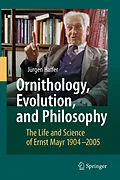This book is the first detailed biography of Ernst Mayr. He was an 'architect' of the Synthetic Theory of Evolution, and the greatest evolutionary biologist since Charles Darwin, influential historian and philosopher of biology, outstanding taxonomist and ornithologist, and naturalist. He is one of the most widely known biologists of the 20th century.
Mayr used the theories of natural selection and population thinking as theoretical models within the framework of historical biological studies. He suggested that various competing paradigms may exist side by side and more or less pronounced 'revolutions' may occur in different fields from time to time. Changes of concepts have a much stronger effect on the development of biological sciences than the discovery of new facts. Mayr was the first to emphasize the role of biopopulations, thereby pointing out the basic difference between 'population thinking' and typological essentialism. Population thinking takes into consideration the uniqueness of each individual and unlimited variation of populations which may lead to the development of new species. On the other hand, typologists assume that the unchanging essence of each species determines variation and fixed limits of variation preclude speciation from occurring except through saltation.
Jürgen Haffer majored in geology and paleontology obtaining a PhD degree at the University of Göttingen. He became an exploration geologist and lived in South and North America, Iran, Egypt, and Norway. During these assignments he studied the bird faunas of Amazonia and Iran and has been in close communication with Ernst Mayr. He also co-published a biography of Erwin Stresemann, Mayr's teacher and friend in Berlin, Germany.
Autorentext
Jürgen Haffer was born in 1932. He majored in geology and paleontology obtaining a PhD degree at the University of Göttingen in 1957. He became an exploration geologist and lived in South and North America, Iran, Egypt, and Norway. During these assignments he studied the bird faunas of Amazonia and Iran and has been in close communication with Ernst Mayr since the early 1960s. He also co-published a biography of Erwin Stresemann, Mayr's teacher and friend in Berlin, Germany.
Klappentext
This book is the first detailed biography of Ernst Mayr. He was an 'architect' of the Synthetic Theory of Evolution, and the greatest evolutionary biologist since Charles Darwin, influential historian and philosopher of biology, outstanding taxonomist and ornithologist, and naturalist. He is one of the most widely known biologists of the 20th century.
Mayr used the theories of natural selection and population thinking as theoretical models within the framework of historical biological studies. He suggested that various competing paradigms may exist side by side and more or less pronounced 'revolutions' may occur in different fields from time to time. Changes of concepts have a much stronger effect on the development of biological sciences than the discovery of new facts. Mayr was the first to emphasize the role of biopopulations, thereby pointing out the basic difference between 'population thinking' and typological essentialism. Population thinking takes into consideration the uniqueness of each individual and unlimited variation of populations which may lead to the development of new species. On the other hand, typologists assume that the unchanging essence of each species determines variation and fixed limits of variation preclude speciation from occurring except through saltation.
Jürgen Haffer majored in geology and paleontology obtaining a PhD degree at the University of Göttingen. He became an exploration geologist and lived in South and North America, Iran, Egypt, and Norway. During these assignments he studied the bird faunas of Amazonia and Iran and has been in close communication with Ernst Mayr. He also co-published a biography of Erwin Stresemann, Mayr's teacher and friend in Berlin, Germany.
Zusammenfassung
Ernst Mayr (19042005), eminent naturalist-systematist and ornithologist, - chitect of the Synthetic Theory of Evolution, leading evolutionary biologist and in?uential historian and philosopher of biology, was asked repeatedly by friends, associates, and peers to write an autobiography, but he always declined such s- gestions because he considered those of other people he knew as inadequate. Moreover, he could not very well talk about himself without bragging, which did not appeal to him. Who else has had a private dinner with the Emperor and - pressofJapan?WhoelsehashadhonorarydegreesfromtheUniversitiesofOxford, Cambridge, Harvard, the Sorbonne, Uppsala, and Berlin? And who else has been able to celebrate the 75th anniversary of his PhD? He also published several au- biographicalaccounts,dictatedcopiousautobiographicalnotes,andannotatedhis bibliography. I had the privilege of using these notes and, in addition, of asking him numerous questions, which he answered patiently in many personal letters. He supported the plan of a biography wholeheartedly from the beginning and reviewed a ?rst draft in detail. In many ways he should be considered a coauthor of this book. As a high school student and eager birdwatcher in Germany, I read Kramer's (1948) extensive review of Mayr's Systematics and the Origin of Species (1942e) and was impressed with the general evolutionary relevance of the discussions and conclusions in this book based, in large part, on his ornithological studies.
Inhalt
The Young Naturalist in Germany.- Childhood and Youth.- The Budding Scientist.- Ornithologist and Evolutionist in New York.- The New York Years (19311953).- Ornithologist and Zoogeographer.- Biological Species and SpeciationMayr's First Synthesis.- Life in North America during World War II.- Professor of Zoology at Harvard University.- The Harvard Years (19532005).- Evolutionary BiologyMayr's Second Synthesis.- Ernst Mayrthe Man.- Systematics and Classification.- History and Philosophy of BiologyMayr's Third Synthesis.- Summary: Appreciation of ErnstMayr's Science.
